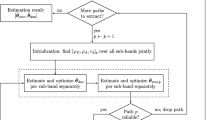Abstract
Radio channel observation and characterization is indispensable in mobile communications systems development. Efficient propagation prediction is crucial for rapid and cost-effective systems deployment. On-site measurements, statistical models, propagation prediction and deterministic modeling are widely used for the qualification of radio channels. In this paper, a simulation tool for deterministic channel modeling in indoor environments is evolved. A hybrid combination of the Method-Of-Moments (MoM) and the Uniform Theory of Diffraction (Utd) is used. Statistical characteristics of a simple office room are calculated and the results are in excellent agreement with corresponding results of relative research on the field.
Résumé
L’observation et la caractérisation du canal de propagation sont indispensables au développement des systèmes de radiocommunication avec les mobiles. Une bonne estimation de la propagation est critique pour le déploiement rapide et à faible coût des systèmes. Des mesures in situ, des modèles statistiques et déterministes de propagation radioélectrique sont largement utilisés pour la qualification du canal de propagation. Dans l’article présenté, un outil d’ingénierie radioélectrique de modélisation déterministe du canal de propagation a été développé. Il est basé sur une méthode hydride combinant la Méthode des Moments et la Théorie Uniforme de la Diffraction. Les caractéristiques statistiques en environnement bureau sont évaluées et les résultats sont conformes aux résultats des recherches correspondantes.
Similar content being viewed by others
References
Paulraj (A.),Nabar (R.),Gore (D.), Introduction to Space-Time Wireless Communications,Cambridge University Press, 2003.
Pahlavan (K.),Levesque (A.H.), Wireless Information Networks,Wiley-Interscience, 1995.
Alexander (S.E.), Radio Propagation Within Buildings at 900 MHz,Iee Electronic Letters,18, pp. 913–914, 1982.
Rappaport (T. S.), Characterization ofUhf Multipath Radio Channels in Factory Buildings,IEEE Transactions on Antennas and Propagation,37, no 8, pp. 1058–1069, August 1989.
Hashemi (H.), Tholl (D.), Statistical Modeling and Simulation of theRms Delay Spread of Indoor Radio Propagation Channels,IEEE Transactions on Vehicular Technology,43, no 1, pp. 110–120, February 1994.
Kim (S.C.), Bertoni (H.L.), Stern (M.), Pulse Propagation Characteristics at 2.4 GHz Inside Buildings,IEEE Transactions on Vehicular Technology,45, no 3, pp. 579–592, August 1996.
Ertel (R.B.), Cardieri (P.), Sowerby (K.W.), Rappaport (T.S.), Reed (J.H.), Overview of Spatial Channel Models for Antenna Array Communications Systems,IEEE Personal Communications,5, no 1, pp. 10–22, February 1998.
Yang (C.F.), Wu (B.C.), Ko (C.J.), A Ray-Tracing Method for Modeling Indoor Wave Propagation and Penetration,IEEE Transactions on Antennas and Propagation,46, no 6, pp. 907–919, June 1998.
Liang (G.), Bertoni (H.K.), A New Approach to 3-D Ray Tracing for Propagation Prediction in Cities,IEEE Transactions on Antennas and Propagation,46, no 6, pp. 853–863, June 1998.
Catedra (M.F.), Perez (J.), Saez De Abana (F.), Gutierrez (O.), Efficient Ray-Tracing Techniques for Three-Dimensional Analyses of Propagation in Mobile Communications: Application to Picocell and Microcell Scenarios,IEEE Antennas and Propagation Magazine,40, no 22, pp. 437–440, April 1998.
Rizk (K.), Wagen (J. F.), Gardiol (F.), Two-Dimensional Ray-Tracing Modeling for Propagation Prediction in Microcellular Environments,IEEE Transactions on Vehicular Technology,46, no 22, pp. 508–518, May 1997.
Wallace (J.W.),Jensen (M.A.), Validation of Parametric DirectionalMimo Channel Models from WidebandFdtd Simulations of a Simple Indoor Environment,IEEE Antennas and Propagation Society International Symposium 2003,2, pp. 535–538.
Papamichael (V.),Soras (C),Makios (V.),Fdtd Modeling and Characterization of the Indoor Radio Propagation Channel in the 434 MHzIsm Band,Icecom 2003, 17th International Conference on Applied Electromagnetics and Communications, 2003, pp. 217–220.
Talbi (L.), Simulation of IndoorUhf Propagation Using Numerical Technique,Canadian Conference on Electrical and Computer Engineering 2001,2, pp. 1357–1362.
Oestges (C), Clerck (B.), Raynaud (L.), Vanhoenacker-Janvier (D.), Deterministic Channel Modeling and Performance Simulation of Microcellular Wide-Band Communication Systems,IEEE Transactions on Vehicular Technology,51, no 6, pp. 1422–1430, November 2002.
O’brien (W.M.), Kenny (E.M.), CUllen (P.J.), An Efficient Implementation of a Three-Dimensional Microcell Propagation Tool for Indoor and Outdoor Urban Environments,IEEE Transactions on Vehicular Technology,49, no 2, pp. 622–630, March 2000.
Zhang (W.), A Wide-Band Propagation Model Based onUtd for Cellular Mobile Radio Communications,IEEE Transactions on Antennas and Propagation,45, no 11, pp. 1669–1678, November 1997.
Fourie (A.), Nitch (D.), SuperNec: antenna and indoor-propagation simulation program,IEEE Antennas and Propagation Magazine,42, no 3, pp. 31–48, June 2000.
Author information
Authors and Affiliations
Additional information
Stelios A. Mitilineos was born in Athens, Greece, in 1977. He received the Diploma in electrical and computer engineering from the National Technical University of Athens (Ntua) in October 2001. He is currently working toward the Ph.D. degree in electrical engineering at the same university. His main research interests are in the area of antennas and propagation, smart antennas and mobile communications, mimo systems and microwave components.
Stylianos C. Panagiotou was born in Athens, Greece, in 1980. He received the Diploma in electrical and computer engineering from the National Technical University of Athens (Ntua), Greece, in 2003. He is currently working toward the Ph.D. degree in electrical engineering at the same university. His main research interests are in the fields of multipara propagation, smart antennas, wireless mimo systems and antenna design.
Pantelis K. Varlamos was born in Athens, Greece, in 1977. He received the Diploma in electrical and computer engineering from the National Technical University of Athens (Ntua) in October 2000. He is currently working toward the Ph.D. degree in electrical engineering at the same university, supported by a scholarship from the Bodossakis Foundation. His main research interests are in the areas of antennas and propagation, smart antennas, and electromagnetic compatibility.
Christos N. Capsalis was born in Nafplion, Greece, in 1956. He received the Diploma in electrical and mechanical engineering from the National Technical University of Athens (Ntua) in 1979 and the B. S. degree in economics from the University of Athens in 1983. He obtained the Ph.D. degree in electrical engineering fromNtua in 1985. He is currently a Professor at the department of Electrical and Computer Engineering inNtua. His current scientific activity concerns satellite and mobile communications, antenna theory and design, and electromagnetic compatibility.
Rights and permissions
About this article
Cite this article
Mitilineos, S.A., Panagiotou, S.C., Varlamos, P.K. et al. Indoor environments propagation simulation using a hybrid MoM and UTD electromagnetic method. Ann. Télécommun. 60, 1231–1243 (2005). https://doi.org/10.1007/BF03219845
Received:
Accepted:
Issue Date:
DOI: https://doi.org/10.1007/BF03219845
Key words
- Electromagnetic wave propagation
- Radio wave
- Indoor radiocommunication
- Numerical simulation
- Moment method
- Wave diffraction
- Deterministic model
- Hybrid model




